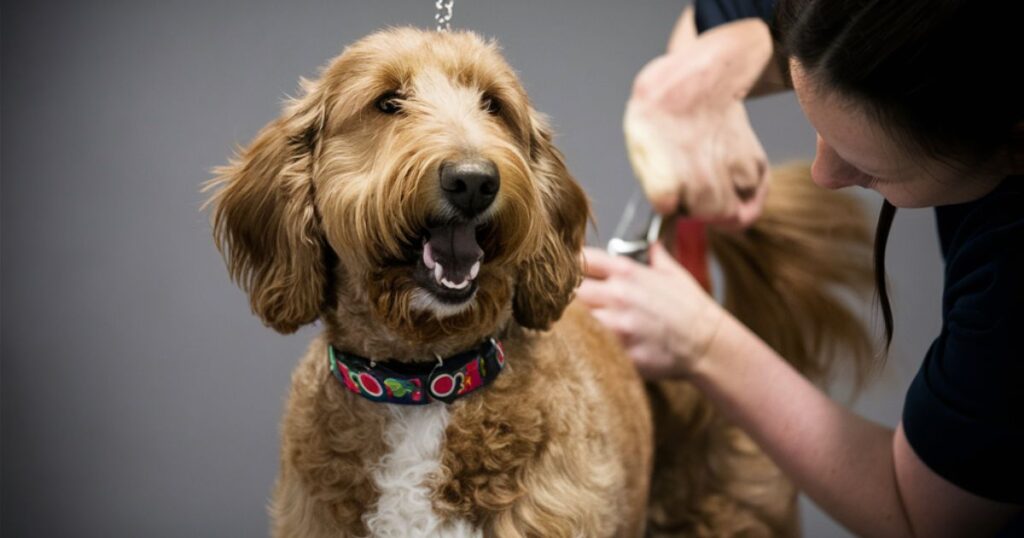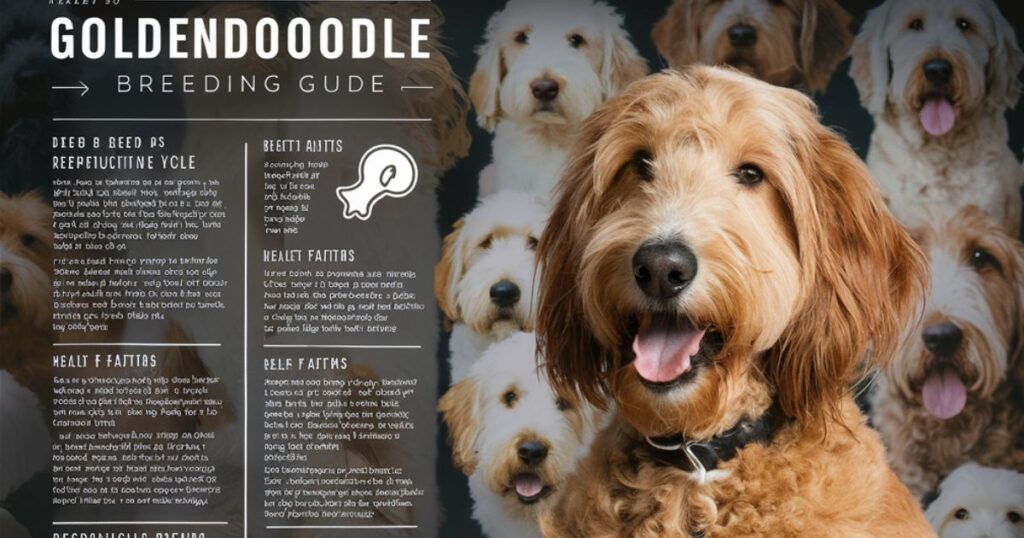The Goldendoodle is a popular hybrid dog breed, a cross between a Golden Retriever and a Poodle. Known for their friendly and affectionate nature, Goldendoodles make excellent family pets and therapy dogs.
They often inherit the intelligence of Poodles and the gentle temperament of Golden Retrievers. Unlock the secrets to responsible Goldendoodle breeding with our comprehensive guide.
The optimal breeding frequency to ensure the health and well-being of both parent dogs and their offspring. From expert tips to ethical considerations, embark on a journey to cultivate thriving generations of Goldendoodles while upholding the highest standards of care.
Learn the essential factors governing Goldendoodle breed frequency in our comprehensive guide. Understand the importance of responsible breeding practices for the health and welfare of both parent dogs and their offspring. Gain insights into optimal breeding intervals, ethical considerations, and expert advice to ensure the well-being of future generations of Goldendoodles.
How do you breed a F2B Goldendoodle?
Goldendoodle breed an F2B Goldendoodle involves selecting parent dogs with specific traits and qualities. Start by choosing a Poodle and a Goldendoodle with desirable genetic characteristics such as temperament, health, and coat type.
Ensure both parents have undergone health screenings to minimize the risk of hereditary diseases in their offspring. Additionally, consider the size, color, and coat texture preferences when selecting breeding pairs.
Next, it’s crucial to understand the genetics behind Goldendoodle breeding. An F2B Goldendoodle is typically the result of crossing two F1B Goldendoodles, often yielding puppies with consistent traits.
Goldendoodle breed the genetic makeup of parent dogs helps predict the traits and characteristics of their offspring accurately. When breeding F2B Goldendoodles, it’s essential to follow ethical breeding practices and prioritize the well-being of both parent dogs and their puppies.
Provide proper care, nutrition, and veterinary attention throughout the breeding process and during the puppies’ early development stages. Responsible breeding also involves finding suitable homes for the puppies and educating new owners about the responsibilities of pet ownership.
Here is a blog for you: https://petplacid.com/mwpfsettlement-com-official-site-for-midwestern-pet-foods-litigation-details-2024/
Can you breed two F1 goldendoodles?
Yes, you can breed two F1 Goldendoodles, but it’s essential to understand the implications. Breeding two F1 Goldendoodles can result in a mix of traits from both parent breeds, including variations in coat type, color, and temperament.

When breeding two F1 Goldendoodles, consider the desired traits and characteristics you want to maintain or enhance in the offspring. Health testing for genetic conditions is crucial to ensure the well-being of the parent dogs and their puppies.
Ethical breeding practices should be followed to prioritize the health and welfare of the dogs involved. Responsible breeders aim to produce healthy, well-tempered puppies that adhere to breed standards and meet the needs of potential owners.
Seeking guidance from experienced breeders or veterinarians can provide valuable insights into the breeding process and help ensure successful outcomes. By carefully planning and executing the breeding of two F1 Goldendoodles, you can contribute to the development and improvement of the Goldendoodle breed.
Complications of breeding too old
Goldendoodle breed dogs at an advanced age can lead to various health complications. Advanced maternal age increases the risk of pregnancy-related issues such as dystocia or difficulty in giving birth.
Similarly, older male dogs may experience reduced fertility, affecting the breeding process and the quality of offspring. Furthermore, older Goldendoodle dogs may have a higher likelihood of passing on genetic disorders to their offspring, impacting the health and well-being of future generations.
Responsible breeding practices involve thorough health screenings and genetic testing to minimize the risk of hereditary diseases. Breeding Goldendoodles beyond their prime reproductive years may also pose risks to the health of the parent dogs.
Pregnancy and whelping can be physically demanding for older females, potentially leading to complications such as uterine inertia or maternal exhaustion. Likewise, older males may experience decreased libido and sperm quality, affecting their ability to sire healthy litters.
Prepare your Goldendoodle for breeding
Preparing your Goldendoodle for breeding involves several essential steps. Begin by ensuring both the male and female Goldendoodle are in optimal health. Regular veterinary check-ups are crucial to address any potential health issues before breeding.

Provide your Goldendoodle with a balanced diet rich in nutrients to support reproductive health. Adequate exercise is also important to maintain your Goldendoodle’s overall well-being and fitness for breeding.
Before breeding, conduct genetic testing to screen for hereditary conditions common in the Goldendoodle breed. This helps ensure the health and vitality of the puppies and prevents the transmission of genetic disorders.
Lastly, consider the timing of breeding carefully, taking into account the female’s heat cycle and the optimal time for conception. By following these steps, you can prepare your Goldendoodle breed and increase the likelihood of a successful and healthy litter.
How many times do goldendoodles need to be groomed?
Grooming is crucial for maintaining the health and appearance of Goldendoodle breed dogs. Typically, Goldendoodles need to be groomed every 6 to 8 weeks to prevent matting and keep their coat in optimal condition.
Regular grooming sessions involve brushing to remove loose hair and prevent tangles, as well as trimming their coat to a manageable length. Pay special attention to sensitive areas like ears and paws to prevent infections and discomfort.
In addition to regular grooming, Goldendoodles may require more frequent grooming during shedding seasons to manage excessive shedding and maintain a tidy appearance. It’s essential to establish a grooming routine early to help Goldendoodles become accustomed to the process and ensure a positive experience.
Consulting with a professional groomer can provide valuable insights into the specific grooming needs of Goldendoodles based on their coat type, lifestyle, and individual preferences. By prioritizing regular grooming, you can help your Goldendoodle stay healthy, comfortable, and looking their best.
Conclusion
The Goldendoodle breed stands out for its unique blend of traits, making it a beloved choice for families and individuals seeking a friendly and intelligent companion. Their hypoallergenic coats and friendly demeanor make them well-suited for various roles, from family pets to therapy dogs.
As the popularity of Goldendoodles continues to rise, it’s essential to prioritize responsible breeding practices to maintain the breed’s health and temperament. By selecting parent dogs carefully and providing proper care throughout the breeding process, we can ensure the continued well-being and happiness of these wonderful dogs.
Frequently Asked Questions
What is the average lifespan of a Goldendoodle?
The average lifespan of a Goldendoodle is around 10 to 15 years.
Are Goldendoodles hypoallergenic?
Yes, Goldendoodles are known for their hypoallergenic coats, making them suitable for people with allergies.
Do Goldendoodles require a lot of grooming?
Yes, Goldendoodles require regular grooming to maintain their coat’s health and prevent matting.

Jackson is a seasoned professional in the field of pets, boasting four years of enriching experience. His expertise spans pet care, training, and health, ensuring insightful and reliable content for pet enthusiasts on our site.







